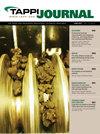柔版油墨与涂料的相互作用:涂料层中乳胶变化的影响
IF 0.6
4区 农林科学
Q4 MATERIALS SCIENCE, PAPER & WOOD
引用次数: 2
摘要
本文所描述的工作的目的是表征涂层和印刷品的结构,并基于物理样品的光学测量来验证油墨和涂层的光学响应和相互作用模型。油墨与涂层的多孔结构之间的相互作用是研究的对象。实验已被用来联系物理条件在柔版印刷夹,油墨设置和由此产生的光学响应。通过对模拟结果和实测结果的比较,表明表面性质的改变是压延处理导致衬底亮度下降的主要原因。考虑表面微粗糙度和有效折射率增加的光散射模拟表明,表面修饰是观测到的亮度下降的主要原因,而体光散射和光吸收系数不受压延的影响。油墨渗透性影响印刷密度、斑点和网点增益。结果表明,油墨的分布受表面粗糙度、孔径差异和孔径分布的强烈影响。对于不同乳胶量和不同乳胶粒径的样品,更高的打印力并没有在很大程度上增加油墨的渗透深度,而是使润湿作用更有效,从而使油墨膜分布更均匀,打印密度更高,未覆盖区域更少。未覆盖区域可能与局部表面粗糙度变化和局部表面润湿性变化有关。不同比例碳酸钙/高岭土颜料的样品,随着涂层中高岭土用量的增加,孔隙率增加,打印密度增加。本文章由计算机程序翻译,如有差异,请以英文原文为准。
Flexographic ink-coating interactions : Effects of latex variations in coating layers
The aim of the work described in this thesis is to characterize the structure of coatings and prints, and to validate models for the optical response and interaction of ink and coating based on optical measurements of physical samples. It is the interactions between the printing ink and the porous structure of the coating layers that are subject to investigation. Experiments have been employed to relate the physical conditions in a flexographic printing nip to the ink setting and the resulting optical response.By comparing simulated and measured results, it was shown that modifications of the surface properties account for the brightness decrease when substrates are calendered. Light scattering simulations, taking into account the surface micro-roughness and the increase in the effective refractive index, showed that surface modifications accounted for most of the observed brightness decrease, whereas the bulk light scattering and light absorption coefficients were not affected by calendering.Ink penetration affects the print density, mottling and dot gain. Results show that ink distribution is strongly affected by surface roughness, differences in pore size and pore size distribution. For samples having different latex amounts and different latex particle sizes, a higher print force did not increase the depth of penetrated ink to any great extent, but rather allowed the wetting to act more efficiently with a more evenly distributed ink film, a higher print density and fewer uncovered areas as a result. Uncovered areas could be linked both to local roughness variations and to local wettability variations on the surface. Samples with different ratios of calcium carbonate/kaolin clay pigment showed an increased porosity and an increase in print density with increasing amount of kaolin in the coating layer.
求助全文
通过发布文献求助,成功后即可免费获取论文全文。
去求助
来源期刊

Tappi Journal
工程技术-材料科学:纸与木材
CiteScore
1.30
自引率
16.70%
发文量
59
审稿时长
6-12 weeks
期刊介绍:
An internationally recognized technical publication for over 60 years, TAPPI Journal (TJ) publishes the latest and most relevant research on the forest products and related industries. A stringent peer-review process and distinguished editorial board of academic and industry experts set TAPPI Journal apart as a reliable source for impactful basic and applied research and technical reviews.
Available at no charge to TAPPI members, each issue of TAPPI Journal features research in pulp, paper, packaging, tissue, nonwovens, converting, bioenergy, nanotechnology or other innovative cellulosic-based products and technologies. Publishing in TAPPI Journal delivers your research to a global audience of colleagues, peers and employers.
 求助内容:
求助内容: 应助结果提醒方式:
应助结果提醒方式:


